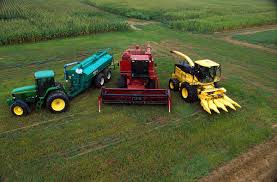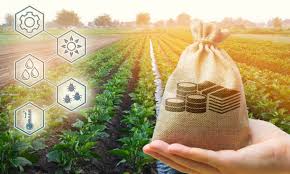Farming grants and subsidies are vital resources provided to farmers to support their agricultural activities. These financial aids play a crucial role in ensuring food security, promoting sustainable farming practices, and bolstering rural economies.
Farming grants are essentially funds allocated by governments or agricultural organizations to assist farmers in various aspects of their farming operations. These grants can be used for a wide range of purposes, including purchasing new equipment, improving infrastructure, implementing sustainable farming practices, and expanding agricultural production.
Subsidies, on the other hand, are financial incentives provided to farmers to reduce the cost of production or to stabilize agricultural markets. These subsidies can take many forms, such as direct payments, price supports, or insurance programs. They are designed to help farmers mitigate risks and ensure a stable income, even in the face of market fluctuations.
One of the primary goals of farming grants and subsidies is to promote sustainable farming practices. Sustainable agriculture focuses on minimizing environmental impact, conserving natural resources, and ensuring the long-term viability of farming. Grants and subsidies often encourage farmers to adopt eco-friendly techniques like crop rotation, organic farming, and efficient water usage.
Moreover, farming grants and subsidies also play a crucial role in enhancing food security. By providing financial support to farmers, governments can ensure a consistent and reliable food supply for their populations. This is especially important in times of crisis or when external factors like climate change or pest infestations threaten crop yields.
In addition to supporting individual farmers, these programs contribute to the overall development of rural communities. When farmers receive grants and subsidies, they can invest in their farms, create jobs, and stimulate economic growth in their regions. This, in turn, leads to improved living standards and increased economic activity in rural areas.
Farming grants and subsidies are not one-size-fits-all; they vary from one region or country to another. Different governments have their own policies and priorities when it comes to supporting agriculture. Some may prioritize the development of specific crops or livestock, while others may focus on technology adoption or environmental conservation.
It’s essential to note that while farming grants and subsidies offer numerous benefits, they also face criticism and challenges. Some argue that these programs can distort market forces, encourage overproduction, and lead to environmental degradation if not properly managed. Therefore, effective administration and monitoring are crucial to ensure that these resources are used efficiently and responsibly.
However, arming grants and subsidies are fundamental tools for supporting agriculture, ensuring food security, and fostering sustainable farming practices. They are essential for the well-being of farmers, rural communities, and the overall stability of the agricultural sector. While they come with their own set of challenges, when managed effectively, they can contribute significantly to the growth and sustainability of the farming industry.
Read Also: Thyme Flowers: Economic Importance, Uses, and by-Products
Benefits of Farming Grants and Subsidies

Farming grants and subsidies offer a wide array of benefits to both farmers and society as a whole. These benefits contribute to the overall development of agriculture, rural communities, and food security. Here are some of the key advantages of farming grants and subsidies:
1. Strengthened Food Security: Grants and subsidies help ensure a stable and consistent food supply by supporting farmers in times of crop failure or market volatility. This is crucial for a nation’s food security, reducing the risk of food shortages and price spikes.
2. Economic Stability for Farmers: These financial aids provide a safety net for farmers, helping them cope with financial challenges such as fluctuating commodity prices, natural disasters, or unexpected expenses. This stability ensures that farmers can continue their agricultural operations and livelihoods.
3. Encouragement of Sustainable Farming Practices: Many grants and subsidies promote sustainable agriculture by incentivizing practices that protect the environment, conserve resources, and reduce the use of harmful chemicals. This benefits the long-term health of both the land and the farming industry.
4. Rural Economic Development: By supporting farmers, grants and subsidies contribute to the economic growth of rural communities. Farmers can invest in their farms, create jobs, and stimulate local businesses, improving the overall quality of life in rural areas.
5. Innovation and Technological Adoption: Some grants encourage farmers to adopt modern technologies and techniques, enhancing agricultural productivity and efficiency. This can lead to higher yields and increased competitiveness in the global market.
6. Diversification of Agriculture: Grants and subsidies can encourage farmers to diversify their crops or livestock, reducing the dependence on a single commodity. This diversification can lead to more resilient farming systems and increased income opportunities.
7. Support for New Farmers: These programs often provide support to new and beginning farmers, helping them overcome the initial barriers to entry in the agriculture sector. This ensures a new generation of farmers can take over as older farmers retire.
8. Environmental Conservation: Grants and subsidies that promote sustainable farming practices also contribute to environmental conservation. Reduced chemical usage, better soil management, and habitat preservation all help protect ecosystems and biodiversity.
9. Market Stability: Subsidies can help stabilize agricultural markets by preventing drastic price fluctuations. This can benefit both farmers and consumers, ensuring fair prices for agricultural products.
10. Compliance with Regulations: Some grants are tied to compliance with environmental or safety regulations. This encourages farmers to adopt responsible practices, contributing to a cleaner environment and safer food production.
In addition , farming grants and subsidies serve as important tools for supporting agriculture, protecting food security, and fostering sustainable farming practices. While they have their challenges and critics, their overall impact is undeniably positive in terms of rural development, economic stability, and the long-term sustainability of the agricultural sector.
Common Types of Farming Grants and Subsidies

There are various types of farming grants and subsidies offered by governments and agricultural organizations worldwide. These programs are designed to address specific agricultural needs and promote various aspects of the farming industry. Here are some common types:
1. Direct Payment Subsidies: These are cash payments provided to farmers based on factors like acreage, historical production, or specific crops or livestock they produce. Direct payments are often used to stabilize farm income and ensure a guaranteed minimum income.
2. Crop Insurance Subsidies: Governments often subsidize crop insurance premiums to encourage farmers to protect their crops against natural disasters, pests, and market fluctuations. This helps farmers manage risks and recover from losses.
3. Price Support Programs: Some governments implement price support mechanisms where they purchase surplus agricultural products from farmers at guaranteed prices. This prevents sharp declines in commodity prices and helps stabilize markets.
4. Conservation Grants: These grants promote sustainable farming practices by providing funding for initiatives like soil conservation, water management, reforestation, and habitat preservation. They aim to protect natural resources while maintaining agricultural productivity.
5. Research and Development Grants: Funding is allocated to agricultural research institutions and universities to support research on crop improvement, pest control, sustainable farming techniques, and technology adoption. The results of such research benefit farmers through increased productivity and efficiency.
6. Rural Development Grants: These grants focus on improving rural infrastructure and community development. They can include funding for building roads, schools, healthcare facilities, and other amenities that enhance the quality of life in rural areas.
7. Beginning Farmer and Rancher Programs: These programs assist new and young farmers in starting and establishing their agricultural operations. Support may include access to land, training, and financial assistance to overcome barriers to entry.
8. Export and Trade Promotion Subsidies: Some countries offer subsidies to agricultural exporters to remain competitive in international markets. These subsidies help reduce the cost of exporting agricultural products.
9. Organic Farming Grants: Governments encourage organic farming by providing grants to farmers who adopt organic practices. These grants often cover certification costs and may offer premium prices for organic products.
10. Value-Added Agriculture Grants: These grants support farmers in adding value to their products, such as processing, packaging, or marketing. They help farmers capture a larger share of the value chain.
11. Disaster Relief Programs: In the event of natural disasters like hurricanes, floods, or droughts, governments may offer emergency grants and subsidies to help farmers recover from losses and continue their operations.
12. Energy Efficiency and Renewable Energy Grants: These grants promote sustainable energy practices on farms, such as installing solar panels, wind turbines, or improving energy efficiency in agricultural operations.
13. Young Farmer Incentives: Some regions offer incentives like low-interest loans or grants to young farmers as a way to encourage generational renewal in agriculture.
These are just a few common types of farming grants and subsidies. The specific programs and eligibility criteria can vary significantly from one country or region to another, reflecting the unique needs and priorities of their agricultural sectors.
Read Also: The Different Breeds of Pigs
Reasons Why Do Farming Grants and Subsidies Exist

Farming grants and subsidies exist for several important reasons, each aimed at addressing specific challenges and objectives within the agricultural sector. Here are the key reasons why these programs exist:
1. Food Security: One of the primary reasons for farming grants and subsidies is to ensure food security. By providing financial support to farmers, governments help maintain a stable and reliable food supply for their populations. This reduces the risk of food shortages and price spikes, especially during times of crisis or market volatility.
2. Income Stability for Farmers: Farming is highly vulnerable to factors beyond a farmer’s control, such as weather events, market fluctuations, and pests. Grants and subsidies serve as a safety net, helping farmers cope with these uncertainties and providing a more stable income. This stability encourages farmers to continue producing food even in challenging conditions.
3. Promotion of Sustainable Practices: Many grants and subsidies encourage the adoption of sustainable farming practices. These programs aim to protect the environment, conserve natural resources, and promote responsible land use. Sustainable agriculture is critical for long-term food production and environmental health.
4. Rural Economic Development: Farming grants and subsidies stimulate economic growth in rural areas. By supporting farmers, these programs allow them to invest in their farms, create jobs, and generate economic activity in their communities. This development improves living standards in rural regions.
5. nnovation and Technological Adoption: Some programs incentivize farmers to adopt modern technologies and farming techniques. This leads to increased agricultural productivity, efficiency, and competitiveness on both domestic and international markets.
6. Diversification of Agriculture: Grants and subsidies can encourage farmers to diversify their crops or livestock, reducing their reliance on a single commodity. This diversification enhances resilience in the face of market fluctuations and environmental challenges.
7. Support for New Farmers: These programs often provide support to new and beginning farmers who may face barriers to entering the agricultural sector, such as high startup costs or limited access to resources. Encouraging new entrants helps maintain generational continuity in farming.
8. Market Stability: Subsidies can help stabilize agricultural markets by preventing extreme price fluctuations. This benefits both farmers and consumers by ensuring fair prices for agricultural products.
9. Compliance with Regulations: Some grants and subsidies are tied to compliance with environmental or safety regulations. This encourages farmers to adopt responsible practices, contributing to a cleaner environment and safer food production.
10. Global Competitiveness: In a globalized economy, farming subsidies can help domestic farmers remain competitive with international counterparts who may receive similar support. This ensures that domestic agriculture can thrive in the global marketplace.
Overall, farming grants and subsidies play a vital role in supporting agriculture, protecting food security, fostering sustainability, and promoting rural development. While they have their challenges and criticisms, their existence is crucial for maintaining a stable and resilient agricultural sector that meets the food needs of growing populations.
Read Also: Extremely Interesting health benefits of Milk you should know today

